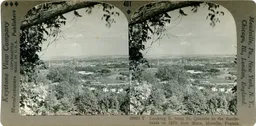Titre
Environ de Metz, Panorama
Datation
Le 22 octobre 1930
Datation min.
1930
Datation max.
1930
Commentaire datation
Datation fournie par les Archives de Californie (voir Bibliographie)
Auteur du cliché
George Lewis
Fonction
Photographe professionnel
Mention d’édition
Keystone View Compagny
Editeur
,
Numéro dans la série
401
Laboratoire photographique
Metz
Légende sur document
29601 T Looking E. from St. Quentin to the Battlefields of 1870, over Metz, Moselle, France.
Commentaire légende
Légende imprimée sous l'image de droite. Encre de couleur noire.
Lieu
Architecture
, , , , ,
Milieu - Environnement
,
Texte au recto
A gauche, verticalement : Keystone View Compagny copyrighted made in U.S.A. Manufacturers Publishers A droite, verticalement : Meadville, Pa., New York, N. Y., Chicago, Ill., London, England. En haut, au centre : 401 Sous l'image de droite : 29601 T Looking E. from St. Quentin to the Battle-fields of 1870, over Metz, Moselle, France.
Verso inscrit
oui
Texte au verso
V3177 LOOKING EASTWARD FROM ST. QUENTIN OVER THE CITY OF METZ, MOSELLE, FRANCE We are on a hill at the west side of the city of Metz, which Caesar described as one of the oldest and most important towns of Gaul when he conquered the latter and took this place, then called Mediomatrica. Owing to its strategic situation, from that day to the present it has been a fortress of great importance and it was never captured by an enemy until 1870. On the 14th of October of that year the French army under Marshal Bazaine, which was defending the fortress, surrendered to the German army under King William I of Prussia after a series of desperate battles and a siege lasting for nearly two months. From our position we see in the distance beyond the town the territory on which occurred two of the battles mentioned; that of Colombey-Nouilly, on August 14, and that of Noisseville, on August 31-September 1, 1870. Behind us, seven miles distant, is the field of the battle of Gravelotte, fought on August 18, which resulted in closing the French army in Metz. When the French surrendered they lost not only the fortress but about 180,000 men and 1,400 cannon. Alsace and Lorraine were seized by Germany and kept until 1918. Then, as a result of the World War, they were returned to France. When the American army captured the St. Mihiel salient in September, 1918, it advanced to within twelve miles of Metz, which would probably have fallen into the hands of the American forces had the war continued a few weeks longer. In 1926 Metz had a population of about 52,000, and important manufactures of hats, artificial flowers, preserves, muslin, and hosiery. Copyright by The Keystone View Company
Analyse du document
Le pont que l'on aperçoit sur la droite de l'image, enjambant la Moselle, a été détruit le 18 novembre 1944.
Bibliographie
https://calisphere.org/item/ark:/13030/kt7z09q28f/
http://promenade.temporelle.free.fr/dotclear/index.php/post/2007/02/27/60-le-pont-du-sauvage-a-longeville-les-metz
Etat de conservation
excellent
Support
Photographies collées sur carton
Dimensions
17,7 x 8,8
Info développement
Positif
Info couleur
Noir et Blanc
Propriétaire
M. Le Menn
Lieu de conservation
Pessac
Auteur de la numérisation
Catherine Carponsin-Martin
Créateur du dépôt
CLEM
Date de dépôt
Octobre 2022
Lot
LOT10 LE MENN
Métadonnées stereo
Nom usuel
LM100
Auteur
George Lewis
Titre
Environ de Metz, Panorama
Date de création
Le 22 octobre 1930
Légende
29601 T Looking E. from St. Quentin to the Battlefields of 1870, over Metz, Moselle, France.
Ville
Metz
Région
Grand Est
Pays
France
Fournisseur
CLEM - Archéovision
Auteur de la description
Chloé Bernard
Métadonnées iptc (stereo)
Nom de l'objet: LM100
Date d'entrée de l'objet dans ArcheoGRID : 2024-12-05
Collection : LOT10 LE MENN


